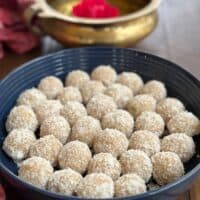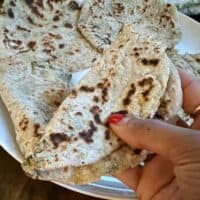Sambhaar is a spicy and tangy curry (soup) made of lentils and vegetables. This is a curry that is typical ‘South Indian’ cuisine and each of the four southern states of Tamil Nadu, Karnataka, Andhra Pradesh and Kerala have their slightly different versions of sambhaar. Sambhaar is eaten with rice but most commonly it is an accompaniment to Idlis and Dosas
Here I am sharing the recipe for Kerala Sambhaar. The taste of the sambhaar to a large extent depends on the different vegetables that go into it. Traditionally in Kerala, a lot of different vegetables are added to sambhaar. These include green plantain, winter melon, green beans, carrots, taro-root(chembu) etc. In addition, sometimes eggplant, okra or radish are added too. The ‘sambhar masala’ is made by browning coconut and then grinding it to a paste with a blend of different roasted lentils and spices. If you want to skip this long version, then you can just use store-bought sambhaar masala instead. Most of the times I use the store bought masala but once in a while for a change I cook the longer version too. In the recipe below, I will show you how to make your own homemade sambhaar masala too.
Also tamarind is used traditionally in this recipe. However of late I have been using Kodampuli instead of tamarind since I avoid tamarind for health reasons. So you can really use either of the two.
 For the most basic sambhaar that I often make I add Dhoodhi (smooth gourd) or winter melon and green pepper (capsicum). Sometimes I only use eggplant or okra. All versions have their slightly different flavors but all of them are delicious nevertheless (as long as it is made with a lot of love!) Drumstick for instance gives sambhaar a very unique flavor and that is another popular version in my house.
For the most basic sambhaar that I often make I add Dhoodhi (smooth gourd) or winter melon and green pepper (capsicum). Sometimes I only use eggplant or okra. All versions have their slightly different flavors but all of them are delicious nevertheless (as long as it is made with a lot of love!) Drumstick for instance gives sambhaar a very unique flavor and that is another popular version in my house.
Step wise pics: Cook vegetables by cooking the harder veggies like plantains and taro root first. Then add green beans and carrots. Add pumpkin/ash gourd towards the end.
Frying the coconut: Take care not to burn it by stirring frequently and heating it at low to medium heat.
- ¾ cup toor dal (yellow split lentils)
- 3 cups water
- ½ med onion
- 2 small tomatoes, cubed
- 1½ tsp salt
- ¼ tsp red chilli
- ¼ tsp turmeric
- 1 green chilli (optional)
- ½ cup smooth gourd
- ½ med capsicum, cubed
- 2 cups any other vegetables,chopped like taro root pieces,
- green beans, carrots, drumsticks
- 1 cup water
- 1 inch dia ball of tamarind soaked in ½ cup water (or 2 small pieces of kodampuli soaked in water)
- 2 tbsp sambhaar powder (store bought or use
- home-made sambhaar masala as shown below*)
- 1 tsp coriander pow
- ½ tsp red chilli(if your sambhar masala is already hot,
- then you can avoid adding more red chili)
- ½ tsp cumin powder
- ½ cup water
- 1 tbsp coconut oil
- 1 tsp mustard seeds
- 1 tsp cumin
- 1 tsp methi seeds
- pinch of asafetida (hing)
- ⅘ curry leaves
- ¼ cup coconut
- 1 tsp urad dal
- 1 tbsp chana dal
- 1 tsp cumin seeds
- 4-5 black pepper
- 1 clove garlic
- 2 dry red chillies
- Wash the lentils 3-4 times under running water until water runs clear. Then add the 3 cups water and add the onions ,tomatoes along with the salt, turmeric, red chilli powder and green chilli and pressure cook for 3 whistles on medium heat. (If not using a pressure cooker, cook in a large pot covered with a lid adding more water until the lentils are soft and well-cooked. ) Keep aside.
- In a separate small pot, cook the vegetables in about 1 cup water. (If using many different vegetables, add the harder vegetables first followed by the softer vegetables in order to avoid overcooking). Add the cooked vegetables into the pot with the cooked lentils.
- Now mix the sambhar masala, red chilli powder, coriander powder, cumin powder in the ½ cup water and then mix with the tamarind pulp (or just add the kodampuli pieces with the soaked water if using those). Add this mixture to the lentils and vegetables mixture and place this back on the heat on medium flame. Add more water if needed to get a soup like consistency. Let simmer for about 4-5 minutes on low heat. Adjust salt.
- Lastly, take a small tadka pan (or small frying pan and heat the coconut oil in it. When hot, add the mustard seeds. When they splutter, add the cumin seeds and methi seeds and stir for about 30 seconds till the methi seeds turn brown. Then add the hing, the dry red chillies and the curry leaves and stir for about 30 seconds more and turn the heat off. Add this tempering to the lentil and vegetable mixture and cover with a lid for about 5 minutes before serving (to make sure the methi seeds get cooked).
- Take a shallow frying pan and heat it on the stove, To this add the grated coconut and roast on medium flame for about 5-7 minutes stirring frequently to avoid uniform toasting and to avoid any scorching or burning of the coconut. When all the coconut is all browned and toasty, add the black pepper corns, dry red chilies ,garlic and cumin seeds and stir for a few more seconds and then transfer to a food processor. Now to the same pan add the urad dal and toast till golden brown and transfer this into the food processor as well. Next fry the chana dal until golden brown and put that in the food processor and grind everything using about ½ cup warm water.
2. Amount of tamarind to use differs depending upon personal tastes - some prefer the tangy sambhaar while some prefer it less tangy. So I recommend you start by adding less of the tamarind pulp as that will allow you to adjust.
3. If using ready made sambhaar masala, different brands have slightly different levels of heat. So again i would recommend starting with less quantity first and then adding more if needed.

























[…] Sambhaar (Lentils and vegetable curry) […]
[…] my daughter loved them! And the idlis tasted great. Served it with the usual accompaniments of sambhar and coconut […]
[…] Pour idli batter onto greased idli moulds and steam in idli cooker for about 10 minutes or until cooked. Serve hot with coconut chutney and sambhaar. […]
[…] tough as having to eliminate tomatoes. All my south Indian ‘go to’ curries … Dal, sambhaar and rasam…need tomatoes! Without tomatoes, they didn’t taste half as good. […]
[…] that is usually for lunch or dinner since I serve them with all the desired accompaniments – sambhaar and chutney and potato masala for masala dosa. So for breakfast it has to be instant dosas! I […]
[…] my dad! Also is a picture of the spread / sadya items for tonight’s Onam Sadya – I made Sambhaar, Avial, Moru kootan, Kumbalanga pachadi, cabbage thoran, kadala and kaaya thoran, matanga erisseri, […]
[…] here I bring you this simple recipe which goes very well with rice and any curry like sambhar or morukootan. The final tadka (tempering) with coconut oil fills your whole house with this […]